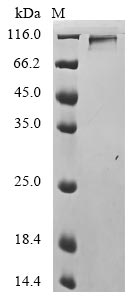Recombinant Influenza A virus Hemagglutinin (HA) is expressed in a mammalian cell system and features a C-terminal hFc1 tag. This partial protein covers the 18-529 amino acid region and shows a purity greater than 90% as confirmed by SDS-PAGE analysis. Designed for research use, it appears to provide a reliable reagent for various scientific applications.
Hemagglutinin (HA) is a crucial surface glycoprotein of the Influenza A virus. It plays a vital role in viral entry into host cells by mediating binding to sialic acid receptors. This protein represents a key target for vaccine development and antiviral research, since it's responsible for the initial steps of infection and is a major determinant of host range and virus transmission.
Potential Applications
Note: The applications listed below are based on what we know about this protein's biological functions, published research, and experience from experts in the field. However, we haven't fully tested all of these applications ourselves yet. We'd recommend running some preliminary tests first to make sure they work for your specific research goals.
The partial sequence (18-529aa) likely covers the ectodomain of HA, which contains key functional regions, but the absence of the full-length sequence (including the transmembrane domain) may affect native trimer stability. The C-terminal hFc1 tag facilitates purification but could potentially sterically interfere with the correct folding of the HA C-terminal region or trimerization, though this risk is lower than with an N-terminal tag. While the mammalian expression system increases the probability of proper folding, the specific folding and bioactivity of this recombinant HA protein must be experimentally validated. It cannot be assumed to be bioactive based on production information alone.
1. Antibody Development and Characterization Studies
This recombinant HA protein could be used as an immunogen or antigen for antibody development only if its folding is confirmed. The mammalian expression system may support native-like glycosylation and conformational epitopes, but the C-terminal hFc1 tag might alter the C-terminal structure or induce tag-specific antibodies, reducing specificity for native HA. The high purity (>90%) minimizes contamination-related issues, but if the protein is misfolded, generated antibodies may fail to recognize the native HA in viral particles or infected cells, limiting utility in neutralization assays. Validation should include testing antibody binding to native HA from influenza viruses.
2. Protein-Protein Interaction Studies
The hFc1 tag enables technical immobilization for pull-down or co-immunoprecipitation assays to study HA interactions with host receptors (e.g., sialic acid) or viral proteins. However, the biological relevance of interactions depends entirely on correct folding. Misfolding could distort interaction interfaces (e.g., the receptor-binding domain), leading to non-physiological bindings (false positives) or missed true interactions (false negatives). The partial sequence (lacking the transmembrane domain) may also affect interactions with membrane-associated partners. Results require validation using full-length, native HA.
3. ELISA-Based Binding and Competition Assays
This protein could serve as a coating antigen or capture reagent in ELISA, with the hFc1 tag allowing oriented immobilization via anti-Fc antibodies to improve sensitivity. However, assay performance is highly dependent on folding state. If the protein is correctly folded, ELISA can reliably measure binding kinetics or antibody responses to conformational epitopes. If misfolded, assays may only detect linear epitopes, compromising sensitivity for neutralizing antibodies or receptor-binding studies. Cross-validation with native HA controls is essential.
4. Structural and Biochemical Characterization
The high purity and mammalian origin make the protein a candidate for biophysical analyses (e.g., dynamic light scattering, mass spectrometry). However, structural studies require rigorous folding validation first. Misfolded or non-homogeneous protein would yield misleading data on stability, oligomerization, or conformation. Techniques like size-exclusion chromatography (to check trimer formation) and circular dichroism (to assess secondary structure) should precede advanced structural work. The hFc1 tag might also interfere with crystallography or NMR.
Final Recommendation & Action Plan
To ensure reliable outcomes, prioritize experimental validation of protein folding and bioactivity before any application. Start with biophysical characterization: use size-exclusion chromatography with multi-angle light scattering (SEC-MALS) to assess oligomeric state (HA should form trimers) and circular dichroism to analyze secondary structure. Then, perform functional assays: test hemagglutination activity (e.g., using red blood cells) or receptor-binding affinity (e.g., via SPR with sialic acid analogs) to confirm bioactivity. If validation succeeds, the protein can be used confidently for the proposed applications, with the caveat that the hFc1 tag and partial sequence may still influence results. If validation fails, restrict use to applications less dependent on native conformation (e.g., linear-epitope antibody production), and always disclose limitations in research communications.






